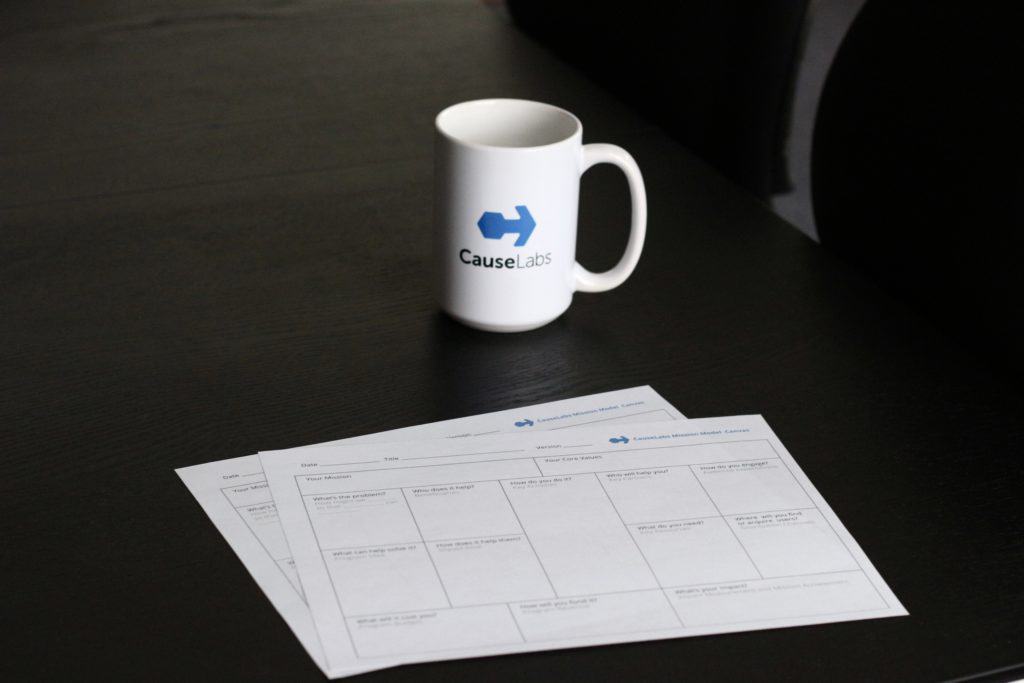In this article, we’ll explore a few more pieces of the CauseLabs Mission Model Canvas to help you fill out your own worksheet. New to the Mission Model Canvas? Read more about it and how it can help you grow positive impact here.
We’ll help guide the considerations for each section, but we won’t go into extensive detail about the strategic process and associated exercises you could work on to arrive at more concrete answers.
This is not intended as a crash course in business or marketing. We hope it is a resource to help you identify if an idea is viable and to uncover where you might need more assistance if you choose to move forward with an idea.
It won’t take long to identify an idea’s strengths and weaknesses at a high level. This is not a 40 page business plan. There are differing opinions on whether or not you need a business plan. However, most agree that having a plan allows you to assess risks and identify opportunities, it allows you to deviate from the plan and identify when to pivot your business, and it allows you to set goals and direction.
The thing that doesn’t happen in a traditional text based plan is that you don’t get to see the gaps in your plan. Instead, there is a lot of effort spent on the sections you can answer. The Mission Model Canvas worksheet doesn’t offer much room to write more than a few sentences. It’s not intended to replace a business plan if you choose to create one. Rather, it’s a business plan cheat sheet. It’s a tool for ideation beyond the initial thought of a product or program. It’s a tool to walk through the process of validating and identifying next steps.
Let’s begin with your mission.
Write your mission statement in the top left. This is a succinct statement of why your business exists. For example, our mission statement at CauseLabs is to use technology as a force for good and deliver amazing client experiences to create positive impact. It doesn’t say specifically what we do with technology and, thinking long-term, it shouldn’t. This mission statement allows my business to evolve as technology evolves. It includes our niche, our brand promise, and our cause to create positive impact.
Remember that your mission statement is different from a vision statement. A vision statement is what the world will look like if you accomplish your mission. If your statement is “so that no child will ever experience hunger.” Then you’re writing a vision statement, and your mission statement may be to provide affordable meals to anyone who needs it. It’s okay to mix them, but it’s also good to know the distinction because you don’t want to set up your business as constantly failing its mission because there are still hungry children.

2. Put your values above all else.
Next, fill in your company’s core values. While your mission will likely never change, your core values may continue to evolve and be refined. This is especially true as new programs, or products are put into place or new team members come on board. Your values reflect the culture of your business and how you operate. For example, we have a value to Radically Respect, and that was further defined to include our planet because we grew in our awareness of a global issue. As a team, we are committed to using green energy and sustainable supply chains.
Now, we can dive into other sections of the Mission Model Canvas that house the specifics of your program or product idea. As you answer each question, see if your answer aligns with your mission and core values. If it doesn’t, star the box to re-evaluate your approach.
3. Define the problem.
The desire when an idea comes to mind is to start planning with the idea at the forefront. We tend to say, “I wish someone would create…” or “Wouldn’t it be great if this existed?” Then, we jump into the idea that we could build it ourselves—what a great idea.
I challenge you to start with the problem you’re trying to solve. We use the human centered design framework for this exercise. I’ll admit it is incredibly hard not to lead with a solution. For services or programs, it is doubly challenging because there is often not a scalable tangible product to test. However, it is not an exercise in futility. Many experts can walk through the process with you. The hesitation is often the time and cost associated with research, observation, and prototyping concepts. Many businesses skip the innovation process and go right to the solution. Sometimes the solution is a replication of an existing business model.
The Mission Model Canvas still works if you’re not the innovator of the solution. The questions are still valid. In this case, you’ll work backwards from the solution. What attracted you to this solution? What problem does it solve that prompted you to explore starting a business? Simon Sinek wrote the book “Start With Why.” Your business “why” is your mission and vision statement, but a product or program why needs to be closer to the root of the problem. The problem is not that there are hungry children. The problem of hunger is different everywhere. In some cases, it’s lack of access to nutritional options. In other instances, the problem is cost. In other areas, the root of the problem could be due to distance, parental education, family structure, unemployment, transportation, discrimination or a child’s allergies or health condition. The list could go on forever. What problem is your solution aiming to solve? That answer belongs in this section, and we’ve provided a model for how to write your problem statement. How might we [root of the problem] so that [people affected] can [specific action that leads to the impact you hope to achieve]?
In the next article, we discuss the following three parts of the MMC: 4. Write a potential solution, 5. Identify who you will help, and 6. answer the question, “How will you make a difference?”

